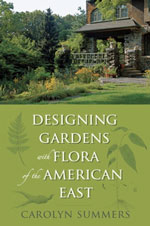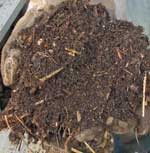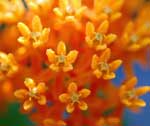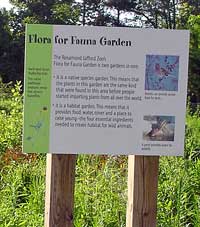| Eat Your Enemy! |
 | | The infamous garlic mustard |
|
Sat. April 16th
10am-1pm
Once again, Baltimore Woods needs you to be part of our special task force against the highly invasive garlic mustard. This edible plant was brought to America as part of pioneer gardens; however, it is invasive and now endangers native woodland wildflowers.
Whether you volunteer pulling garlic mustard or sprucing up the grounds, gardens and trails, you will be treated to a lunch that features unique and delicious dishes featuring garlic mustard as the special ingredient. Bring your friends and eat your enemy! Please register with Baltimore Woods at
673-1350.
|
| Carolyn Summers workshop | 
| |
We had a very informative and enjoyable workshop last Saturday at Baltimore Woods.
Thank you to HGCNYers Carol Biesemeyer, Soule Leiter, and John Allen as well as to Linda Bonnell and Thea Reidy, our colleagues at Baltimore Woods. Karen Hanford provided truly gracious hospitality to our speaker and our committees. If you weren't able to attend, check out Carolyn Summers' book. |
| Master Composter Class |
 | | Compost |
|
A master composting class is being offered at Northern Onondaga Public Library Mon.-Wed. May 2, 3, 4 from 6:00 pm to 8:00 pm $15 fee includes supplies for a vermicompost bin and worms. Call 699-2032 to register or register online.
|
| Native Plants for Native Birds |
 | | Native Plants for Native Birds by Joel Baines; published by Cayuga Bird Club |
| |
Very appropriate guide for CNY! Available at Wild Birds Unlimited in Fayetteville (but call first to see if it's still in stock).
Highly recommended by Carolyn Summers at the workshop. |
| April 19: National Hanging Out Day | 
| April 19 is the National Hanging Out Day -- laundry, that is.
Besides saving about $25/month on energy costs and increasing the life of clothes, hanging clothes on the line is the easiest way to take advantage of solar energy.
Find out more about Hanging Out Day and about the Top Ten Reasons to line dry.
Leave some space in your habitat garden for Hanging Out!
|
|
Join HGCNY!
|  |
Becoming an official member of HGCNY is easy: just join Wild Ones! When you're a Wild Ones member, you're automatically an official member of HGCNY. |
|
Greetings!
 We're pleased to have Jim D'Angelo, director of Sterling Nature Center, return for another of his popular presentations. This year Jim will be talking about dragonflies, a fascinating creature we can enjoy in our own yards.
(NOTE that this "April" program is in May this year due to the Easter holiday.)
 Special! Special! We'll have some butterfly weed (Asclepias tuberosa) milkweed plants for sale at the meeting, courtesy of Dave Mitchell, butterfly weed grower par excellence.
Time/Place: Le Moyne College Library Special Activities Room at 2:00 pm Sunday May 1. (Directions) Habitat Gardening Series: I'll be presenting a series of six programs on habitat gardening topics Saturdays from April 30 through June 11 (except for June 4) at 2:00 - 3:30 at Baltimore Woods. Register for any or all of these programs with Baltimore Woods. Janet |
|
|
Help out at the zoo's Flora for Fauna garden this year
 | | "Flora for Fauna Garden": sign at the zoo's habitat garden |
The zoo's habitat
garden has increasingly provided habitat for wildlife over the last few years as the plantings have matured, but unless it's maintained its future is uncertain.
Habitat gardeners to the rescue! Not only is this the ideal service project for habitat gardeners, but it's a wonderful learning opportunity for anyone volunteering. What better way to learn about plants in all stages of growth than to work alongside more knowledgeable gardeners? Soon, you'll be one of those knowledgeable gardeners, too. (And besides contributing service and gaining knowledge, this is also an excellent way to get to know some other people with similar interests.)
Any help is appreciated, but what Flora for Fauna really needs is a core group who can be relied upon to (usually) show up once a week for about 2 hours.
If you're interested, contact Kate Woodle.
Unless someone like you cares a whole awful lot, nothing is going to get better. It's not. ~ Dr. Suess, The Lorax |
 | | Male goldfinch, not yet completely gold |
"The wild canaries have returned!!"
Wild canaries returning? This quotation from a someone in Central New York illustrates two misconceptions.
First, the person quoted thinks those yellow birds she's seeing are "wild canaries" escaped from their cages, though they're actually goldfinches, a native bird.
Second, she thought they had just "returned" to Central New York, whereas they had been here all winter.
Both mistakes are understandable. On first glance goldfinches are very similar to the canaries we see in cages. And these yellow birds have just started becoming noticeable after the long winter.
In reality, though, they were here all along, but in their rather drab olive winter garb. The males are now donning their brilliant summer gold, just the thing for attracting females.
Some interesting facts about goldfinches:
- Goldfinches are one of the few birds that do not rely on insects.
- Goldfinches are the only finch that molts twice a year.
- Goldfinches breed later than most birds, waiting for milkweeds and thistles to produce down for their nests and also taking time to recover from the stress of molting.
Learn more about this common, yet unusual, bird from Cornell's Lab of Ornithology All About Birds and from The Birds of North America Online. |
|
Featured plant: Bloodroot
 | | A piece of bloodroot's root |
Bloodroot (Sanguinaria canadensis) comes by its name honestly--just look at the photo and you can see why. It's also a good illustration of how the scientific botanical names for plants are chosen: "sanguis" is the Latin word for "blood."
 Bloodroots are one of the first spring wildflowers, one of the spring ephemerals--and ephemeral they certainly are! As William Cullina says in his Wildflowers book, after just a few days the petals fall to the ground in "confettiesque heaps before the leaves fully expand. They have a pure crystalline quality so befitting a life so brief." Bloodroots are one of the first spring wildflowers, one of the spring ephemerals--and ephemeral they certainly are! As William Cullina says in his Wildflowers book, after just a few days the petals fall to the ground in "confettiesque heaps before the leaves fully expand. They have a pure crystalline quality so befitting a life so brief."
Even though the flowers are fleeting, the longer-lasting foliage that emerges is equally unique and beautiful.
The photo shows the single form of the flowers. Although double-flowered forms are cultivated, bees aren't as likely to get much-needed spring nectar from the double flowers as from the single ones. |

Project BudBurst is a citizen science project that monitors plants as the seasons change. People collect information about the timing of leafing, flowering, and fruiting of plants, called plant phenophases.
Thousands of people across the US have participated in PBB since it began in 2007. You can, too! It's an important way you can help scientists understand our changing environment.
All ages can participate, making it a perfect family project. There's no cost to participate, and no special training is needed.
To participate, choose one or more plants to monitor. Some are extremely common plants, such as dandelion or common lilac (this is not a native plant project), and some are less common, but you're sure to find at least some plants on the list in your yard.
All the information you need is at www.budburst.org .
|
|
|
|
|